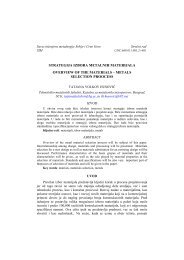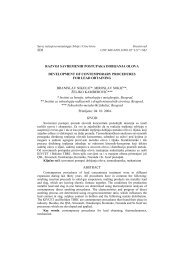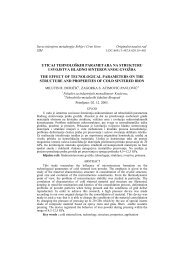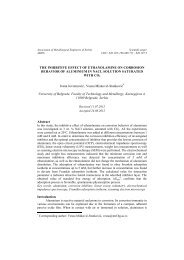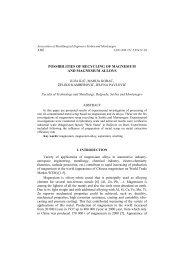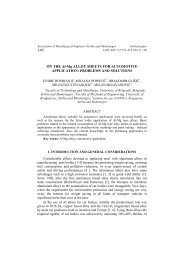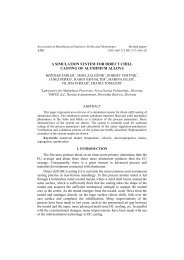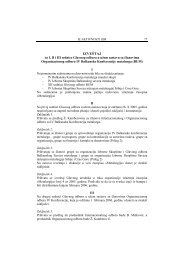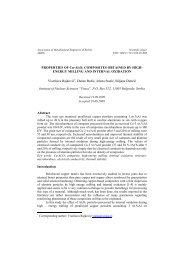ferrous metallurgy center of the brnjica cultural group - CEON
ferrous metallurgy center of the brnjica cultural group - CEON
ferrous metallurgy center of the brnjica cultural group - CEON
You also want an ePaper? Increase the reach of your titles
YUMPU automatically turns print PDFs into web optimized ePapers that Google loves.
FERROUS METALLURGY CENTER OF THE BRNJICA CULTURAL ... 109<br />
The context (grave finds) <strong>of</strong> individual artefacts point out that <strong>the</strong> <strong>ferrous</strong><br />
products were exceptionally appreciated during <strong>the</strong> 14 th –13 th centuries BC in <strong>the</strong><br />
Pomoravlje region (along <strong>the</strong> Morava rivers), not only as expensive products but as<br />
objects <strong>of</strong> definite symbolic meaning.<br />
Hisar in Leskovac was <strong>the</strong> only settlement within <strong>the</strong> central Balkan region<br />
from <strong>the</strong> period <strong>of</strong> <strong>the</strong> 14 th –13 th centuries BC with a fortification – an acropolis <strong>of</strong><br />
several hectares <strong>of</strong> land. Its location (at <strong>the</strong> crossing points <strong>of</strong> roads leading along<br />
<strong>the</strong> Jablanica and Veternica rivers’ valleys and along <strong>the</strong> Morava river valley), its<br />
size (<strong>of</strong> several hectares), its continuity (14 th –13 th centuries BC), permanent<br />
development, specialized features <strong>of</strong> individual parts <strong>of</strong> <strong>the</strong> settlement (acropolis,<br />
metallurgic <strong>center</strong>, bone processing <strong>center</strong>, representative architecture (habitations<br />
decorated in Mycenaean style plastics), variety <strong>of</strong> ceramics (diverse forms,<br />
extraordinary quality, richness <strong>of</strong> decoration, Mycenaean style imitations), – all <strong>of</strong><br />
<strong>the</strong>se confirm that <strong>the</strong> settlement at <strong>the</strong> Hisar location in Leskovac was <strong>the</strong> most<br />
representative one and undoubtedly <strong>the</strong> main settlement <strong>of</strong> <strong>the</strong> Brnjica community,<br />
<strong>the</strong> largest and <strong>the</strong> only one artificially fortified settlement within <strong>the</strong> whole central<br />
Balkan region during <strong>the</strong> last centuries <strong>of</strong> <strong>the</strong> second millennium BC.<br />
The settlement, being <strong>the</strong> largest within <strong>the</strong> whole central Balkan region, as<br />
already emphasized, distinguishes itself by two characteristics. It has its fortification<br />
– acropolis, protected by a moat and a rampart, its bronze and iron metallurgic and<br />
handicrafts <strong>center</strong>s and a separate bone processing <strong>center</strong>. In all cultures and periods<br />
<strong>of</strong> time, metallurgic <strong>center</strong>s, particularly <strong>the</strong> iron ones, were under <strong>the</strong> protection <strong>of</strong><br />
fortified palaces i.e. <strong>of</strong> fortifications.<br />
The earliest iron <strong>metallurgy</strong> (in <strong>the</strong> second half <strong>of</strong> <strong>the</strong> second millennium BC)<br />
in <strong>the</strong> Middle East was carried out explicitly under <strong>the</strong> auspices <strong>of</strong> <strong>the</strong> capital <strong>of</strong> <strong>the</strong><br />
state and <strong>the</strong> ruling palace [11]. The Hisar settlement in Leskovac from <strong>the</strong> second<br />
half <strong>of</strong> <strong>the</strong> second millennium BC reproduces <strong>the</strong> same pattern.<br />
It might be supposed that knowledge <strong>of</strong> iron <strong>metallurgy</strong> arrived to Pomoravlje<br />
from <strong>the</strong> Mycenaean area, <strong>the</strong> same as <strong>the</strong> influences manifested in <strong>the</strong> architectural<br />
plastics (to be found at Hisar) as well as in painted ceramics. The Mycenaean<br />
civilization reached its culmination in <strong>the</strong> 14 th –13 th centuries BC, greatly because <strong>of</strong><br />
<strong>the</strong> monopoly both <strong>of</strong> production and distribution <strong>of</strong> bronze artefacts across <strong>the</strong><br />
significant part <strong>of</strong> <strong>the</strong> Mediterranean. On Mycenaean territory were found <strong>ferrous</strong><br />
artefacts, but <strong>the</strong>re is no pro<strong>of</strong> <strong>of</strong> local <strong>metallurgy</strong> <strong>of</strong> <strong>the</strong> metal, which makes it<br />
certain that <strong>the</strong>se <strong>ferrous</strong> artefacts were imported from <strong>the</strong> Middle East (<strong>the</strong> same as<br />
in Egypt) [12]. It seems, however, that <strong>the</strong> <strong>ferrous</strong> artefacts stemming from <strong>the</strong><br />
Mycenaean soil are younger as compared to <strong>the</strong> <strong>ferrous</strong> artefacts belonging to <strong>the</strong><br />
Brnjica <strong>cultural</strong> <strong>group</strong> from Pomoravlje. Moreover, it seems that <strong>the</strong> Mycenaean<br />
interest for some communities in Pomoravlje, such as <strong>the</strong> one belonging to <strong>the</strong><br />
settlement in Leskovac, proved by architectural plastics and painted ceramics – was<br />
at least partly motivated by possibility to acquire iron. Even if <strong>the</strong> Mycenaean<br />
community had <strong>the</strong> knowledge to produce iron, it was much easier for <strong>the</strong>m to get it<br />
through barter from outside than to produce it on its own soil because <strong>of</strong> <strong>the</strong><br />
energetic shortage (lack <strong>of</strong> wood) <strong>of</strong> <strong>the</strong> civilization from <strong>the</strong> south <strong>of</strong> <strong>the</strong> Balkan<br />
Peninsula.<br />
There are reliable pro<strong>of</strong>s <strong>of</strong> iron utilization by all <strong>the</strong> central Balkan<br />
communities as well as that <strong>the</strong> Brnjice community, as already mentioned, mastered<br />
<strong>the</strong> iron <strong>metallurgy</strong> and handicrafts based on this metal in its early stage (ca. 1350<br />
BC) [13]. Moreover, all <strong>ferrous</strong> artefacts found in <strong>the</strong> central Balkan region come




